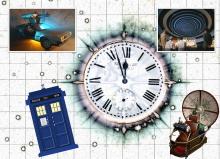Listen to today's episode of StarDate on the web the same day it airs in high-quality streaming audio without any extra ads or announcements. Choose a $8 one-month pass, or listen every day for a year for just $30.
You are here
Keeping Time II
A day on Earth consists of 24 hours, 1,440 minutes, or 86,400 seconds. But not all days are equal. Earth’s rotation on its axis varies from day to day. Earthquakes and hurricanes, for example, can cause “hiccups” that alter the length of the day ever so slightly. It’s not nearly enough to notice. But it means that we can’t rely on Earth’s rotation to keep highly accurate time. So scientists have devised several time systems to compensate.
The basic system is known as Universal Time. But there are several versions of it. The one that’s used for everyday clocks is Universal Time Coordinated. It’s based on International Atomic Time, which keeps time with atomic clocks.
Scientists use Universal Time 1. It is based on the motions of astronomical objects and artificial satellites across the sky. A network of radio telescopes plots the positions of distant quasars, for example, with extreme precision. It tells astronomers how long it takes those objects to return to the same position in the sky — a highly accurate clock.
Astronomers also use a system known as Terrestrial Time. It figures time as though Earth were a smooth, featureless ball. That’s because clocks at different altitudes tick at slightly different rates. Adjusting them to the same altitude compensates for those differences.
Today, Terrestrial Time has drifted ahead of atomic time — by about 32 seconds.
More about time tomorrow.
Script by Damond Benningfield





